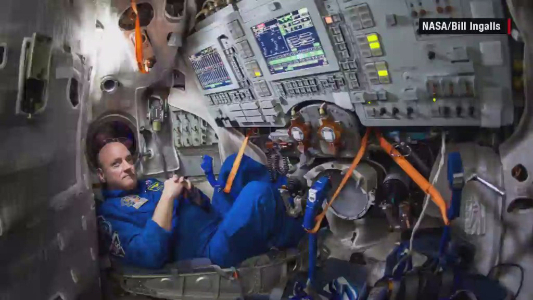NASA astronaut Scott Kelly is preparing to leave Earth for a very long time — and to make U.S. spaceflight history. On Friday at 3:42 p.m. ET, Kelly will ride a Russian Soyuz rocket to the International Space Station and stay there nearly a year, twice as long as any U.S. astronaut has ever stayed on the space station.
“It’s a lot of fun,” Kelly said at a media briefing in January. “Space station is a magical place.”
Two cosmonauts will ride up with Kelly: Mikhail Kornienko and Gennady Padalka. Kornienko also will stay up for a year. Padalka will only stay up for six months.
The trio will join three crew members already on the space station: U.S. astronaut Terry Virts, Russian cosmonaut Anton Shkaplerov and Italian astronaut Samantha Cristoforetti. Other crew members also will rotate in and out during their year in orbit so it will never be just Kelly and Kornienko on the station.
Kelly, 51, will break the record for the longest mission on the space station set by NASA astronaut Michael Lopez-Alegria and Russian cosmonaut Mikhail Tyurin. They spent over seven months on the ISS — from September 18, 2006, to April 21, 2007.
He will spend 342 days off the planet on this mission. When added to his previous space missions, that will give him a total of 522 days in space, breaking the record of U.S. astronaut Mike Fincke. Fincke spent a combined 381 days, 15 hours and 11 minutes in space, according to his official NASA bio.
While Kelly is setting space station and other U.S. records, Padalka will be setting a record for the most total time in space for a human. He’s already spent more than 710 days in space, including stays on Russia’s Mir space station and three previous stints on the International Space Station.
Why do it? Why stay up on the station so long? NASA wants to know more about the impact of long-duration spaceflights on the human body to help plan missions to Mars and deeper into space. And the space station is the best place available to study that.
The station orbits about 250 miles above the Earth. That’s not too far if you drive it on land. But it’s far enough above the planet to when you go straight up, you nearly run out of gravity. And it turns out the human body really likes gravity. NASA says space station astronauts have vision changes, bone loss, muscle atrophy and other problems.
The space station has about the same living space as a six-bedroom, two bathroom house. And it has a 360-degree bay window with a great view. But astronauts and cosmonauts still report feeling isolated and confined at times. Kelly will keep a journal for researchers, documenting his feelings about being away from his two children and the rest of his family.
“I’m going to keep a personal journal of the experience,” Kelly said. He also will share some of his journal with researchers studying the psychological impacts of long-term space flight. Will he tell all?
“I plan to be completely honest about it,” he said, but … “who knows, maybe there are some crazy thoughts I’ll have at the end that I wouldn’t want to share.”
Kelly’s family includes his twin brother — retired astronaut Mark Kelly.
Mark Kelly has volunteered for NASA’s “Twins Study” to see how the identical twins change over the year in two very different environments.
“He thinks it’s great that he can still be a participant in this,” Scott Kelly said.
So Mark will be on Earth getting poked and prodded by researchers — while Scott makes history in orbit.
